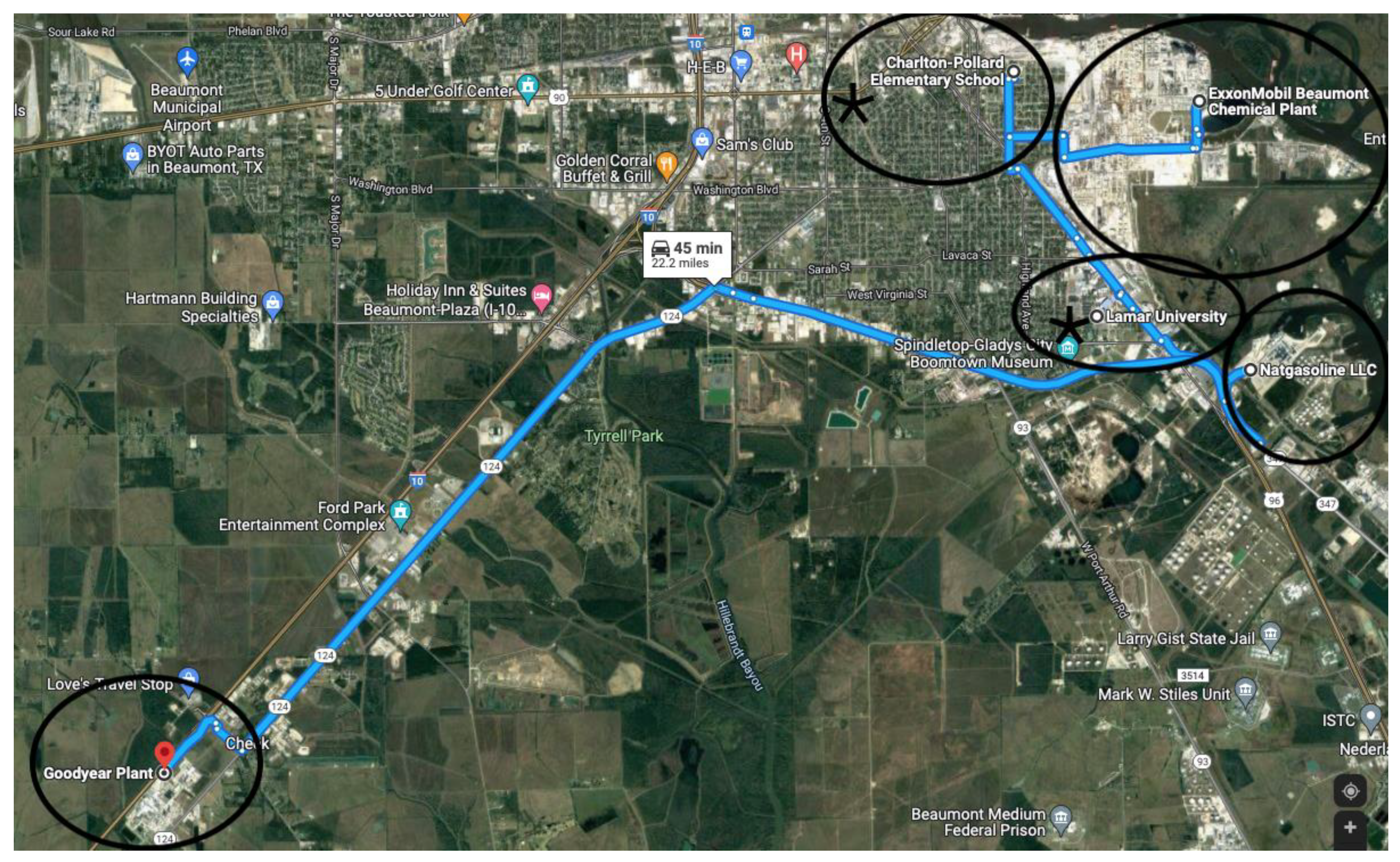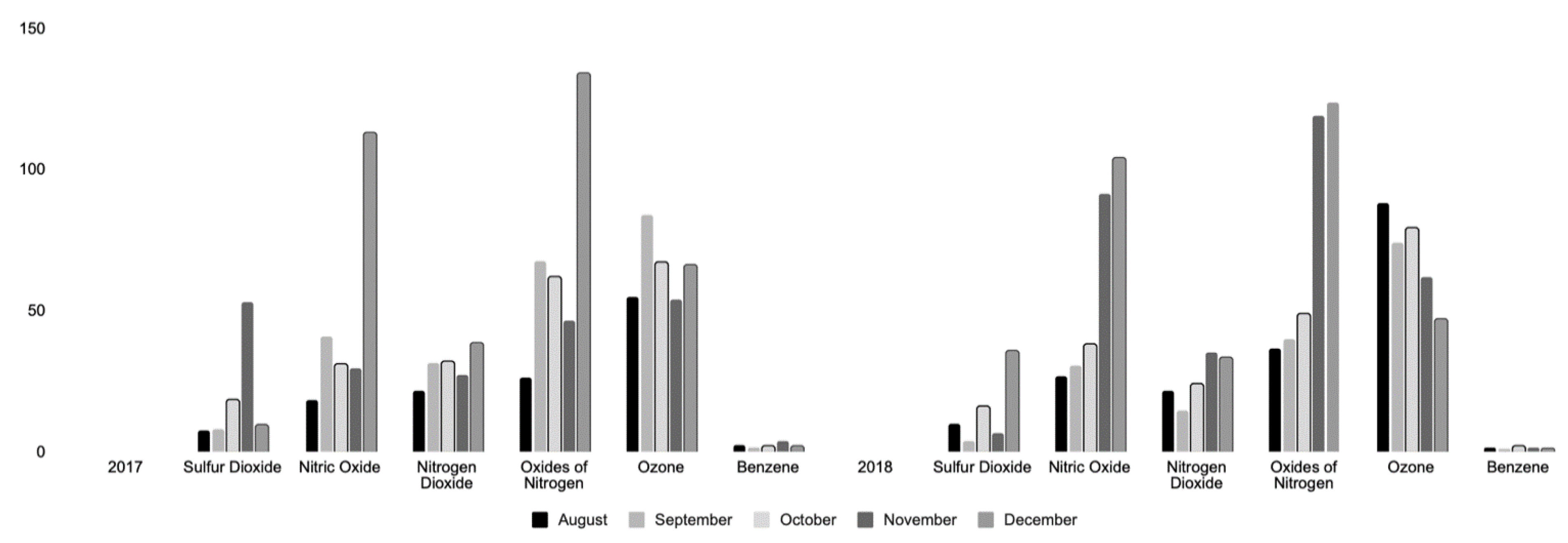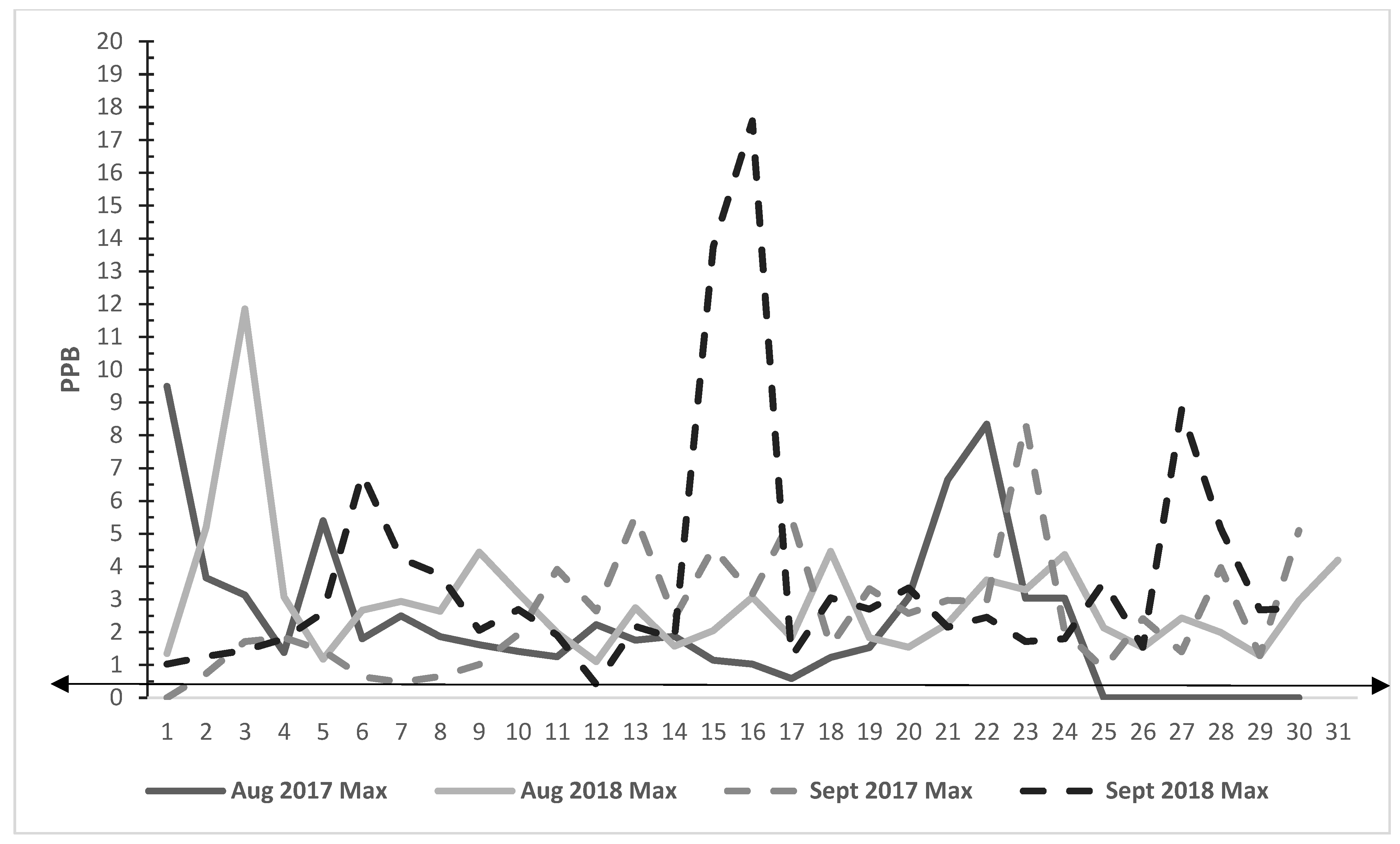An Exploratory Investigation of Government Air Monitoring Data after Hurricane Harvey
Abstract
:1. Introduction
2. Methods
3. Results
4. Conclusions
Author Contributions
Funding
Institutional Review Board Statement
Informed Consent Statement
Data Availability Statement
Conflicts of Interest
References
- World Health Organization (WHO). Ambient (Outdoor) Air Quality and Health. 2018. Available online: https://www.who.int/news-room/fact-sheets/detail/ambient-(outdoor)-air-quality-and-health (accessed on 10 June 2020).
- Kurt, O.K.; Zhang, J.; Pinkerton, E.K. Pulmonary Health Effects of Air Pollution. Curr. Opin. Pulm. 2016, 22, 138. [Google Scholar] [CrossRef] [PubMed]
- Kelly, J.F. Influence of Air Pollution on Respiratory Disease. EMJ Respir 2014, 2, 96–103. [Google Scholar]
- Faustini, A.; Safoggia, M.; Colais, P.; Berti, G.; Bistani, L.; Cadium, E.; Cernigliaro, A.; Mallone, S.; Scarnato, C.; Forastiere, F. Air pollution and multiple acute respiratory outcomes. Eur. Respir. J. 2013, 42, 304–313. [Google Scholar] [CrossRef] [PubMed] [Green Version]
- American Lung Association: Children and Air Pollution. 2019. Available online: https://www.lung.org (accessed on 10 June 2019).
- Brook, R.D.; Franklin, B.; Cascio, W.; Hong, Y.; Howard, G.; Lipsett, M.; Luepker, R.; Mittleman, M.; Samet, J.; Smith, S.C., Jr.; et al. Air Pollution and Cardiovascular Disease. CIR 2004, 109, 2655–2671. [Google Scholar] [CrossRef] [PubMed]
- WHO. How Air Pollution Is Destroying Our Health. 2019. Available online: https://www.who.int/air-pollution/news-and-events/how-air-pollution-is-destroying-our-health (accessed on 13 June 2019).
- Mudu, P.; Terracini, B.; Martuzzi, M. (Eds.) Human Health in Areas with Industrial Contamination. Copenhagen ”WHO Regional Office for Europe 2014. Available online: https://apps.who.int/iris/bitstream/handle/10665/144490/Human%20Health%20in%20Areas%20with%20Industrial%20Contamination%20(Eng).pdf?sequence=1 (accessed on 13 June 2019).
- Cristian, G.; Marti, M.; Manolis, K. Health effects of non-occupational exposure to oil extraction. Environ. Health 2016, 15, 1–4. [Google Scholar] [CrossRef] [Green Version]
- White, N.; teWaterNaude, J.; van der Walt, A.; Ravenscroft, G.; Roberts, W.; Ehrlich, R. Meteorologically estimated exposure but not distance predicts asthma symptoms in schoolchildren in the environs of a petrochemical refinery: A cross-sectional study. Environ. Health 2009, 8, 45. [Google Scholar] [CrossRef] [PubMed] [Green Version]
- Cheng-Kaun, L.; Heu-Yang, H.; David, C.C.; Francesco, F.; Ro-Ting, L. Lung cancer mortality of residents living near petrochemical industrial complexes: A meta-analysis. Environ. Health 2017, 16, 101. [Google Scholar] [CrossRef] [Green Version]
- Jean, B.D.; Juliana, M.A.; Chakrabort, J. Residential Proximity to Environmental Hazards and Adverse Health Outcomes. Am. J. Public Health 2011, 101, S37–S52. [Google Scholar] [CrossRef]
- Pornpimol, K.; Panawadee, S.; Witaya, Y.; Suttinin, C.; Dusit, S. Health Effects of People Living Close to a Petrochemical. J. Med. Assoc. Thai. 2013, 96 (Suppl. 5), 64–72. [Google Scholar]
- WHO: Chemical Releases Associated with Floods. 2018. Available online: https://apps.who.int/iris/bitstream/handle/10665/272392/WHO-CED-PHE-EPE-18.02-eng.pdf (accessed on 27 June 2019).
- National Hurricane Center. Costliest U.S Tropical Cyclones Tables Updated. 2018. Available online: https://www.nhc.noaa.gov/news/UpdatedCostliest.pdf (accessed on 6 May 2019).
- Kimberly, A. Hurricane Harvey Facts, Damage and Costs. The Balance. 2019. Available online: https://www.thebalance.com/hurricane-harvey-facts-damage-costs-4150087 (accessed on 3 May 2019).
- Mosier, J. Texas Plants Spewed 8 Million Pounds of Air Pollutants as Hurricane Harvey Hit. 2018. Available online: https://phys.org/news/2018-08-texas-spewed-million-pounds-air.html (accessed on 3 May 2019).
- Mealer, B. Y’all Smell That? That’s the Smell of Money. Available online: https://www.texasmonthly.com/news-politics/yall-smell-that-thats-the-smell-of-money/ (accessed on 2 February 2022).
- U.S Census Bureau. Quick Facts Beaumont Texas. 2010. Available online: https://www.census.gov/quickfacts/fact/table/beaumontcitytexas/PST120218 (accessed on 24 June 2019).
- Christus Dubuis Hospital of Beaumont Port Arthur: Community Health Needs Assessment. 2019. Available online: https://www.christushealth.org/-/media/files/homepage/giving-back/chna/2017--2019-chna-dubuis-beaumontport-arthur-rev.ashx?la=en (accessed on 1 July 2020).
- Sadasivam, N. Experts: Much of Harvey-Related Air Pollution Was Preventable. Available online: https://www.texasobserver.org/early-shut-downs-upgrades-could-have-avoided-millions-of-pounds-of-pollutants-released-during-harvey/ (accessed on 6 February 2022).
- Google Maps, 2022. Available online: https://www.google.com/maps/dir/1086+Vermont+Avenue,+Beaumont,+TX/Charlton-Pollard+Elementary+School,+825+Jackson+St,+Beaumont,+TX+77701/598+Craig+Street,+Beaumont,+TX/Lamar+University,+4400+S+M+L+King+Jr+Pkwy,+Beaumont,+TX+77705/Port+of+Beaumont,+Main+Street,+Beaumont,+TX/@30.0576325,-94.097531,14z/data=!3m1!4b1!4m32!4m31!1m5!1m1!1s0x863eca77b90acd41:0x647edd42d05bea!2m2!1d-94.0710576!2d30.0364384!1m5!1m1!1s0x863eca95962a86fd:0x705d60f50de6ef63!2m2!1d-94.0872752!2d30.0712602!1m5!1m1!1s0x863ecaea10a8085d:0xd34bdf0bc2c0635a!2m2!1d-94.095008!2d30.071266!1m5!1m1!1s0x863eca78b5046bcb:0xa10be6fcc4ffd91f!2m2!1d-94.0747071!2d30.0392256!1m5!1m1!1s0x863ecac07f74306f:0xb140c5a09ee160d7!2m2!1d-94.092493!2d30.0792731!3e0 (accessed on 22 February 2022).
- Texas Commission on Environmental Quality(TCEQ). 2019. Available online: https://www.tceq.texas.gov/agency/about-the-tceq (accessed on 19 June 2019).
- Environmental and Energy Study Institute: After the Storm: Texas Begins to Assess Environmental Impacts of Hurricane Harvey. 2017. Available online: https://www.eesi.org/articles/view/after-the-storm-houston-begins-to-assess-environmental-impacts-of-hurricane (accessed on 26 June 2019).
- Angelevska, B.; Atanasovski, M.; Andreevski, I.; Arapinoski, B. Real-time urban air pollution monitoring using unmanned aerial vehicles. Int. Sci. J. 2020, 8, 29–32. [Google Scholar]
- EPA: Particulate Matter Basics. 2018. Available online: https://www.epa.gov/pm-pollution/particulate-matter-pm-basics#PM (accessed on 4 June 2019).
- Li, M.H.; Fan, L.C.; Mao, B.; Yang, J.W.; Choi, A.M.; Cao, W.J.; Xu, J.F. Short-term Exposure to Ambient Fine Particulate Matter Increases Hospitalizations and Mortality in COPD: A Systematic Review and Meta-analysis. Chest 2016, 149, 447–458. [Google Scholar] [CrossRef] [PubMed]
- EPA (ATSDR) Hydrogen Sulfide Fact Sheet. Available online: http://www.epa.gov/sites/default/files/2017-12/documents/appendix_e-atsdr_h2s_factsheet.pdf (accessed on 26 March 2022).
- Skelton Eleanor. TCEQ Says Sulfur Dioxide Levels No Longer Elevated in Beaumont. The Examiner. 2016. Available online: http://theexaminer.com/stories/news/tceq-says-sulfur-dioxide-levels-no-longer-elevated-beaumont (accessed on 3 July 2019).




| MAX | SH | MIN | AVG | SD | CAP (%) | Missing Hours | Missing Days | |
|---|---|---|---|---|---|---|---|---|
| Sulfur Dioxide 2017 2018 | 53.7 40.9 | 52.9 38.7 | −0.3 −0.4 | 0.5 0.5 | 1.3 1.4 | 95.8 98.4 | 179 138 | 8 0 |
| Nitric Oxide 2017 2018 | 113.4 103.9 | 101.5 91.6 | −0.7 −0.5 | 1.2 1.2 | 3.4 3.3 | 94.1 97.9 | 249 187 | 11 0 |
| Nitrogen Dioxide 2017 2018 | 38.3 43.7 | 36.7 39.9 | 0.3 0 | 5.8 5.8 | 5.0 4.8 | 94.1 97.9 | 245 187 | 11 0 |
| Oxides of Nitrogen 2017 2018 | 134.0 123.8 | 127.8 118.9 | 0.2 0 | 6.9 6.8 | 14 14 | 95.6 97.4 | 271 176 | 8 0 |
| Ozone 2017 2018 | 88 96 | 84 94 | −2 −4 | 24 23 | 14 14 | 95.6 97.4 | 192 153 | 8 3 |
| Benzene 2017 2018 | 7.29 27.6 | 5.28 3.40 | 0 0 | 0.22 0.15 | 0.3 0.4 | 88.9 93.3 | 1103 1137 | 22 4 |
| MAX | SH | MIN | AVG | SD | CAP (%) | Missing Hours | Missing Days | |
|---|---|---|---|---|---|---|---|---|
| 2017 | 17.18 | 11.44 | −0.33 | 0.68 | 1.02 | 39.1 | 195 | 213 |
| 2018 | 24.30 | 20.46 | −0.40 | 0.53 | 1.07 | 92.5 | 583 | 3 |
Publisher’s Note: MDPI stays neutral with regard to jurisdictional claims in published maps and institutional affiliations. |
© 2022 by the authors. Licensee MDPI, Basel, Switzerland. This article is an open access article distributed under the terms and conditions of the Creative Commons Attribution (CC BY) license (https://creativecommons.org/licenses/by/4.0/).
Share and Cite
Adair, K.; Miller, S.; Gage Witvliet, M. An Exploratory Investigation of Government Air Monitoring Data after Hurricane Harvey. Int. J. Environ. Res. Public Health 2022, 19, 5559. https://doi.org/10.3390/ijerph19095559
Adair K, Miller S, Gage Witvliet M. An Exploratory Investigation of Government Air Monitoring Data after Hurricane Harvey. International Journal of Environmental Research and Public Health. 2022; 19(9):5559. https://doi.org/10.3390/ijerph19095559
Chicago/Turabian StyleAdair, Kwanita, Shelly Miller, and Margot Gage Witvliet. 2022. "An Exploratory Investigation of Government Air Monitoring Data after Hurricane Harvey" International Journal of Environmental Research and Public Health 19, no. 9: 5559. https://doi.org/10.3390/ijerph19095559
APA StyleAdair, K., Miller, S., & Gage Witvliet, M. (2022). An Exploratory Investigation of Government Air Monitoring Data after Hurricane Harvey. International Journal of Environmental Research and Public Health, 19(9), 5559. https://doi.org/10.3390/ijerph19095559






